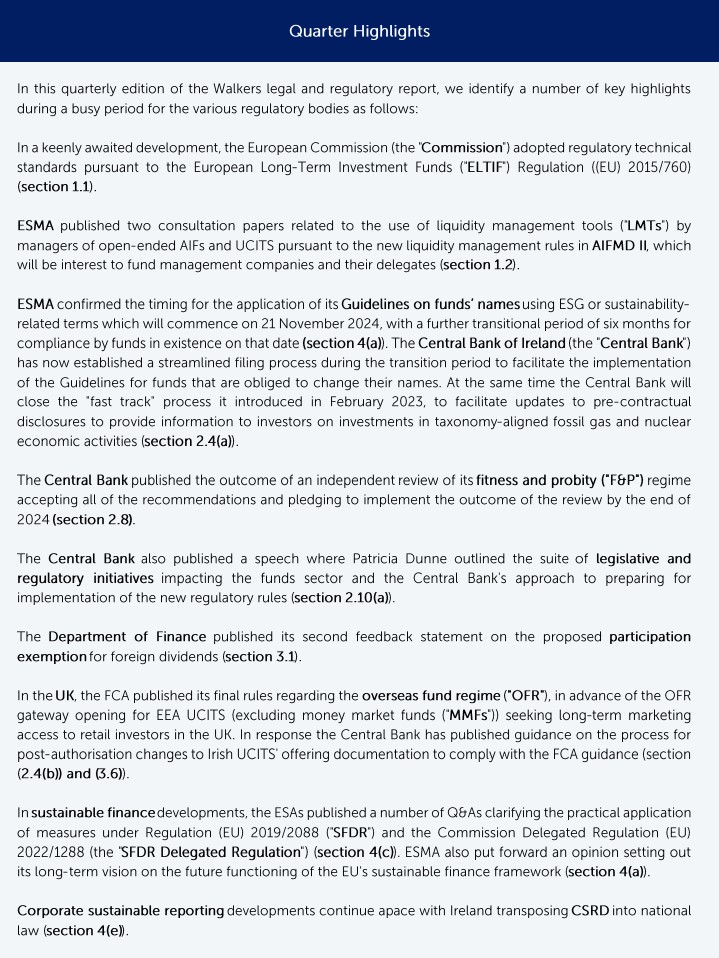Irish Quarterly Legal And Regulatory Report: Asset Management And Investment Funds July – September 2024 – Fund Finance – Finance and Banking


1. AIFMD & UCITS DEVELOPMENTS
1.1 Commission adopts delegated regulation on the ELTIF
Regulation (This is a further update to section 4.3(a) of the
quarterly report covering the second quarter of 2024)
On 19 July 2024, the European Commission (the
“Commission“) adopted a delegated
regulation and accompanying annexes containing its regulatory technical standards
(“RTS“) supplementing Regulation EU
2015/760, as amended by Regulation 2023/606/EU (the
“ELTIF Regulation“).
The RTS specify detail on a number of features mandated under
the ELTIF Regulation, in particular:
- the circumstances in which the life of an ELTIF is considered
compatible with the life cycles of each of the individual assets,
as well as different features of the redemption policy of the ELTIF
(including the minimum holding period, choice of liquidity
management tools (“LMTs“), notice
periods and maximum percentage of liquid assets that can be
redeemed); - the circumstances for the use of a liquidity matching
mechanism, i.e. the possibility of full or partial matching (before
the end of the life of the ELTIF) of transfer requests of units or
shares of the ELTIF by exiting ELTIF investors with transfer
requests by potential investors; - the criteria for establishing the circumstances in which the
use of financial derivative instruments solely serves the purpose
of hedging risks inherent in certain investments; and - the ELTIF costs disclosure.
The key features of the adopted RTS include, but are not limited
to, provisions on the following:
Notice periods and redemption frequency
(open-ended ELTIFs)
The Commission’s re-working of ESMA’s original proposals
constitutes its proportional approach to calculating allowable
redemptions from an open-ended ELTIF. Discretion is provided in the
RTS for ELTIF managers to calibrate the gating of redemptions
either on the basis of:
(i) the redemption frequency and the maximum length of the
notice period, which represents the notice period (per the tables
in annex I) or, alternatively,
(ii) on the basis of the redemption frequency and the minimum
percentage of liquid assets (per the table in annex II).
Under both methodologies the manager of the ELTIF may consider
introducing a minimum notice period as part of the redemption
policy without the mandating of a minimum notice period under the
RTS. Significantly, in determining the maximum redemption gate
ELTIF managers may apply the sum of UCITS eligible assets at the
redemption date, as well as the expected cash flow forecasted on a
prudent basis over 12 months. ELTIF managers may only take into
account those expected positive cash flows for which the ELTIF
manager can demonstrate that there is a high degree of certainty
that they will materialise and shall not consider as expected
positive cash flows the possibility that the ELTIF can raise
capital through new subscriptions.
Minimum holding period (open-ended
ELTIFs)
While a minimum holding period can enable managers of ELTIFs
which offer redemption facilities to complete the investments of
its capital contributions, the RTS do not prescribe the duration of
the minimum holding period. Instead, the manager of an ELTIF in
considering the circumstances of the ELTIF should determine the
requirement for any minimum holding period based on a set of
certain criteria.
LMTs (open-ended ELTIFs)
The RTS clarify that the manager of an open-ended ELTIF is not
required to, but may at its discretion and in accordance with the
redemption policy, select and implement 4321from among any of the
following anti-dilution LMTs:
(a) anti-dilution levies;
(b) swing pricing; and
(c) redemption fees.
The manager of the ELTIF may also additionally select and
implement other LMTs. The manager of a retail investor ELTIF should
provide the competent authority of the ELTIF, upon request of that
authority, with the information on the choice of such other LMTs
and their appropriateness in the context of the ELTIF.
Costs
The RTS also provides for common definitions, calculation
methodologies and presentation formats to ensure a common approach
in relation to the disclosure of the costs (borne directly or
indirectly) by investors in an ELTIF.
Next steps
Following adoption by the Commission, a three-month scrutiny
period by the co-legislators has been triggered following which the
RTS may be published and enter into force the day after its
publication. The adoption of the RTS has been keenly awaited and
the approach taken by the Commission demonstrates a recognition of
those concerns expressed by stakeholders as well as an effort to
mitigate these concerns while also maintaining the protection of
retail investors, ensuring the fulfilment of financial
stability-related objectives of the capital markets union as well
as maintaining the initial momentum behind the ELTIF 2.0
regime.
Walkers’ Asset Management & Investment Funds team have
published a recent advisory assessing the RTS, as well as its
implications and next steps.
1.2 Corrigendum to the ELTIF Regulation
On 17 September 2024, a Corrigendum to the ELTIF Regulation (EU)
2023/606 was published in the official journal of the EU (the
“OJ“).
The text corrects a typographical error in Article 19 of the
consolidated ELTIF Regulation entitled ‘Secondary
Market‘ (replacing a number of references to
‘existing… investors’ with ‘exiting…
investors’).
1.3 ESMA consultations on AIFMD II LMTs (This is a further
update to section 1.1 of the quarterly report covering the first
quarter of 2024)
On 8 July 2024, ESMA published the following consultations on
LMTs for funds pursuant to mandates in Directive (EU) 2024/927 of
the European Parliament and of the Council of 13 March 2024
amending AIFMD (2011/61/EU) and the UCITS Directive (2009/65/EC)
relating to delegation arrangements, liquidity risk management,
supervisory reporting, provision of depositary and custody
services, and loan origination by alternative investment funds
(“AIFs”) (“AIFMD II”).
The Draft Guidelines and Draft RTS will apply to alternative
investment fund managers (“AIFMs“)
managing open-ended AIFs and UCITS and are to be read together.
ESMA notes that the aim of the draft RTS and guidelines is to
promote convergent application of the Directives for both UCITS and
open-ended AIFs and make EU FMCs better equipped to manage the
liquidity of their funds, in preparation for market stress
situations. In addition, they clarify the functioning of specific
LMTs, such as the use of side pockets, which is a practice that
currently varies significantly across the EU.
AIFMD II requires FMCs of open-ended AIFs and UCITS to select at
least two LMTs from those set out in points 2 to 8 of Annex V of
the AIFMD and Annex IIA of the UCITS Directive (these lists are
identical), having assessed that suitability of those LMTs in
relation to the pursued investment strategy, the liquidity profile
and the redemption policy of the fund. FMCs may also decide to use
other tools (than the LMTs referred to in AIFMD II) to manage the
liquidity of a fund. However, when doing so, these other tools
shall not be considered as LMTs for the purpose of complying with
AIFMD II. One example noted by ESMA of these other tools is
“soft closure”, where a fund is closed to new
subscriptions when the size of the fund exceeds a pre-determined
level, while still allowing investors to redeem. The Draft RTS do
not mandate the conditions under which the LMTs selected shall be
activated (except for side pockets), and ESMA identifies its
expectations and instances that may lead to the activation of all
LMTs.
The Draft LMT Guidelines outline how FMCs should select
(selection relates to other LMTs only, as funds need to always be
able to implement suspension of dealing procedures and side pockets
without pre-selecting those) and calibrate LMTs, in light of their
investment strategy, their liquidity profile and the redemption
policy of the fund.
LMTs should be considered an essential (but not the sole)
element of the fund’s overall liquidity management framework,
which should incorporate relevant provisions related to the
fund’s structure, investment strategy and operational processes
and procedures to manage liquidity. The primary responsibility for
liquidity risk management, including for the selection,
calibration, activation and deactivation of LMTs remains with the
AIFMs (acting on behalf of open-ended AIFs) or the UCITS
respectively.
The Draft Guidelines also recommend that, in the selection of
the two minimum mandatory LMTs, FMCs should consider, where
appropriate, the merit of selecting at least one quantitative-based
LMT (i.e, redemption gates and extension of notice period)
and at least one anti-dilution (or price-based
tool (“ADT“) (i.e. redemption fees,
swing pricing, dual pricing, anti-dilution levies)), taking into
consideration the investment strategy, redemption policy and
liquidity profile of the fund and the market conditions under which
the LMT could be activated. In this context, FMCs may consider
whether to select one LMT to use under normal market conditions and
one LMT to be used under stressed market conditions (for instance,
one ADT to use for normal market conditions and one quantitative
LMT to be used under stressed market conditions).
Investor disclosure
The Draft Guidelines emphasise appropriate disclosure of
available LMTs in the fund documentation, and/or periodic reports
(e.g. a periodic report would provide an ex-post overview of
activation whereas fund rules and prospectuses would state the
conditions for activating am LMT). The implications of LMTs in
terms of liquidity costs or access to their capital should also be
disclosed. ESMA has noted that such disclosures should help to
normalise the use of LMTs and increase the understanding of their
functioning by investors, while the timing and detail of disclosure
should balance any unintended consequences such as preventing any
first mover advantage. ESMA also suggests that it may be helpful
for funds to disclose periodic ex-post information on the
historical use of LMT to investors via the fund’s financial
statements or via a website.
Governance
AIFMD II requires that detailed policies and procedures for the
activation and deactivation of any of the selected LMTs and the
operational and administrative arrangements for the use of such LMT
must be implemented. The selected LMTs and the detailed policies
and procedures must be communicated to the national competent
authority (“NCA“) of the UCITS or AIFM.
AIFMD II requires that an AIFM or UCITS must notify its home state
NCA, without delay, where it activates or deactivates suspension of
subscriptions, repurchases and redemptions or any of the
‘selected’ LMTs in a manner that is not in the ordinary
course of business as envisaged in the AIF/UCITS rules or
instruments of incorporation.
In respect of governance principles and following IOSCO
recommendations for liquidity risk management for collective
investment schemes the Draft Guideline
(i) objective criteria (e.g. activation thresholds) for the
application of LMTs;
(ii) methodology, including calibration;
(iii) parties involved (e.g. senior management, risk management,
etc);
(iv) source of information and data used;
(v) controls;
(vi) documentation of decisions made;
(vii) escalation processes; and
(viii) oversight by the governing body.
The Draft Guidelines also note that depositaries should set up
appropriate verification procedures on the FMC documented
procedures for LMTs. The consultations seek feedback
from stakeholders before 8 October 2024. ESMA will deliver final
reports outlining the final RTS and LMT Guidelines to the
Commission by 16 April 2025. ESMA will also consult on draft RTS to
determine the requirements that loan-originating AIFs must comply
with to maintain an open-ended structure pursuant to AIFMD II at a
later stage.
The Walkers’ Asset Management & Investment Funds 101
advisory series considers a number of key changes for the asset
management industry under AIFMD II. In the first advisory of the series our Irish Asset
Management and Investment Funds team explain the new harmonised
framework for loan originating activities across the EU and in the
second instalment of the series, we focus on
the new legal framework provided under AIFMD II in relation to the
use of LMTs.
1.4 ESMA updated Q&As
On 12 July 2024, ESMA has published the following updated Q&As,
including on AIFMD and the UCITS Directive:
AIFMD Q&A
Initial capital and additional own funds
Q&A 2227 notes that internally managed
AIFs and self-managed UCITS investment companies should adopt
procedures and systems to ensure compliance at all times with the
requirements related to own funds per Article 9 of AIFMD and
Articles 7 and 29 of the UCITS Directive.
The Q&A clarifies the initial capital and the additional own
funds should not be included in the fund’s net asset value
(“NAV“), i.e. kept separate from the
collective investment undertaking’s assets. As a result, an
investment company’s own funds should be neither invested in
accordance with the funds’ investment strategy nor distributed
to the redeeming investors, but instead they should be preserved to
cover exposures from the investment company’s professional
liability and they should always remain within the limits of the
minimum capital requirements.
Notification upon establishment of a branch
Q&A 711 notes that when an AIFM intends to
carry out in another member state solely the functions referred to
in point 2(c) of Annex I to AIFMD, such as real estate
administration activities either directly or through establishing a
branch, a notification to the competent authorities of its home
member state under Article 33(2) and (3) AIFMD is not required in
such instances.
The functions listed in point 2 of Annex I AIFMD are ancillary
to the activities referred to in point 1 of Annex I to AIFMD and
cannot be exercised independently from those. However, the AIFM may
still need to provide information to the competent authorities of
its home member state under different legal bases (e.g. Article
7(2)(c) on the requirement to provide upon authorisation a program
of activity setting out the organisational structure of the
AIFM).
Q&A on the UCITS Directive
Derogation for newly authorised UCITS
Q&A 601 confirms that under Article 57(1)
of the UCITS Directive the six-month period member states may allow
recently authorised UCITS to derogate from Articles 52 to 55 runs
from the date of authorisation of the UCITS, regardless of whether
the UCITS launches immediately after authorisation or at a later
stage.
2. CENTRAL BANK UPDATES
2.1 Cross-border passporting process update
On 20 August 2024, the Central Bank communicated to Irish Funds
that the following cross-border passporting submissions are with
effect from 11 September 2024, required to be submitted via the
Central Bank’s online portal (the
“Portal“) (instead of via email):
- UCITS outward marketing submissions – notifications and
de-notifications; - Article 32 AIFMD outward marketing submissions, i.e., Irish
AIFMs marketing EU AIFs in EU member states (excluding Ireland)
– notifications and de-notifications; and - Article 31 AIFMD inward marketing submissions, i.e., Irish
AIFMs marketing EU AIFs in Ireland – notifications and
de-notifications.
Note that any passporting submissions not listed above will
continue using the relevant email mailbox submission
process.
Third party entities appointed to make passporting
notifications/de-notifications must have relevant Portal
permissions assigned to them by the relevant Portal Administrator
for UCITS and AIFMs. To this end the Central Bank notes that Irish
AIFMs which intend to passport EU AIFs, as well as any legal
advisors and/or other filing representatives to which the Portal
tasks will be delegated, should complete the Portal registration
process where they are not already registered. The nominated Portal
Administrator for each EU AIF should complete the link on the
Portal to the relevant EU AIF.
To read the full article click here
The content of this article is intended to provide a general
guide to the subject matter. Specialist advice should be sought
about your specific circumstances.
link






